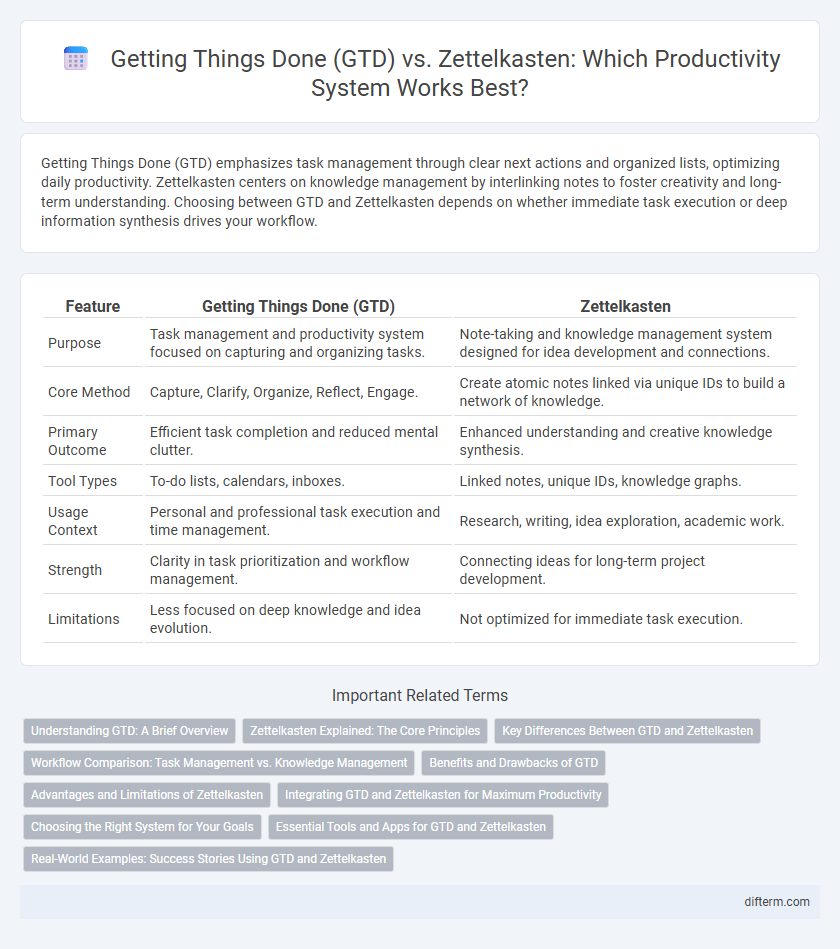Getting Things Done (GTD) emphasizes task management through clear next actions and organized lists, optimizing daily productivity. Zettelkasten centers on knowledge management by interlinking notes to foster creativity and long-term understanding. Choosing between GTD and Zettelkasten depends on whether immediate task execution or deep information synthesis drives your workflow.
Table of Comparison
| Feature | Getting Things Done (GTD) | Zettelkasten |
|---|---|---|
| Purpose | Task management and productivity system focused on capturing and organizing tasks. | Note-taking and knowledge management system designed for idea development and connections. |
| Core Method | Capture, Clarify, Organize, Reflect, Engage. | Create atomic notes linked via unique IDs to build a network of knowledge. |
| Primary Outcome | Efficient task completion and reduced mental clutter. | Enhanced understanding and creative knowledge synthesis. |
| Tool Types | To-do lists, calendars, inboxes. | Linked notes, unique IDs, knowledge graphs. |
| Usage Context | Personal and professional task execution and time management. | Research, writing, idea exploration, academic work. |
| Strength | Clarity in task prioritization and workflow management. | Connecting ideas for long-term project development. |
| Limitations | Less focused on deep knowledge and idea evolution. | Not optimized for immediate task execution. |
Understanding GTD: A Brief Overview
Getting Things Done (GTD) is a productivity methodology developed by David Allen that emphasizes organizing tasks through a clear workflow of capturing, clarifying, organizing, reflecting, and engaging. GTD focuses on externalizing all tasks and commitments into trusted systems like lists and calendars to reduce mental clutter and enhance focus. This method promotes regular reviews and prioritization, enabling users to manage responsibilities efficiently and maintain a consistent productivity rhythm.
Zettelkasten Explained: The Core Principles
Zettelkasten is a knowledge management system designed to enhance productivity by organizing information through atomic notes linked by unique identifiers. Its core principles include granular note-taking, non-linear connectivity, and the creation of a dynamic web of ideas that promotes efficient retrieval and creative thinking. Unlike Getting Things Done (GTD), which emphasizes task organization, Zettelkasten focuses on long-term knowledge development and idea synthesis.
Key Differences Between GTD and Zettelkasten
Getting Things Done (GTD) centers on task and project management, emphasizing clear next actions and organized workflows to boost productivity. Zettelkasten, by contrast, is a knowledge management system designed around interconnected notes that foster idea development and long-term learning. The key difference lies in GTD's focus on executing tasks efficiently, while Zettelkasten prioritizes structuring and linking knowledge for creativity and insight generation.
Workflow Comparison: Task Management vs. Knowledge Management
Getting Things Done (GTD) prioritizes task management by breaking down projects into actionable tasks with clear next steps and deadlines to increase productivity. Zettelkasten focuses on knowledge management through interconnected notes that promote idea development and long-term understanding. While GTD streamlines task execution and completion, Zettelkasten enhances information retrieval and cognitive linking.
Benefits and Drawbacks of GTD
Getting Things Done (GTD) enhances productivity by providing a structured framework for task management, allowing users to capture, clarify, organize, reflect, and engage with tasks efficiently. Benefits of GTD include reducing mental clutter and increasing focus by breaking down projects into actionable steps, while drawbacks involve the time investment required to maintain the system and potential overwhelm for beginners due to its complexity. Although GTD excels at task execution and workflow management, it may lack the deep knowledge synthesis emphasized by systems like Zettelkasten.
Advantages and Limitations of Zettelkasten
Zettelkasten excels in knowledge management by creating interconnected notes that enhance long-term learning and idea development, making it ideal for research-intensive productivity. Its limitations include a steep initial setup time and the need for consistent maintenance to avoid note overload or fragmentation. Unlike Getting Things Done (GTD), which prioritizes task execution and immediate productivity, Zettelkasten focuses on cumulative understanding and insight generation over time.
Integrating GTD and Zettelkasten for Maximum Productivity
Integrating Getting Things Done (GTD) with the Zettelkasten method streamlines task management and knowledge retention, enhancing overall productivity. GTD's structured task capture and action planning complement Zettelkasten's interconnected note-taking system, creating a dynamic workflow for idea development and execution. Leveraging both methods allows for efficient processing of commitments while maintaining a robust, searchable knowledge base that supports long-term project success.
Choosing the Right System for Your Goals
Choosing the right productivity system depends on your primary goals: Getting Things Done (GTD) excels in task management and workflow clarity by breaking down projects into actionable items, while Zettelkasten focuses on knowledge management and idea development through interconnected notes. GTD suits professionals who need to efficiently organize tasks and deadlines, whereas Zettelkasten benefits researchers, writers, and lifelong learners aiming to build a personal knowledge base. Aligning your choice with specific objectives enhances productivity by leveraging the strengths of either task-oriented organization or deep intellectual exploration.
Essential Tools and Apps for GTD and Zettelkasten
Getting Things Done (GTD) relies on essential tools like task managers such as Todoist, Microsoft To Do, or OmniFocus that support project organization, next actions, and context tagging. Zettelkasten benefits from note-taking apps like Obsidian, Roam Research, or Zettlr, which enable backlinking and the creation of a dynamic, interconnected knowledge base. Both systems gain productivity boosts when using digital tools that streamline workflow management and knowledge retrieval effectively.
Real-World Examples: Success Stories Using GTD and Zettelkasten
GTD has propelled productivity in companies like Apple, where structured task management enhances project delivery and individual output, while Zettelkasten thrives in academic settings, exemplified by Nobel laureate Niklas Luhmann's prolific research and writing output. Professionals using GTD report increased efficiency through clear action lists and regular reviews, whereas Zettelkasten users achieve deeper knowledge integration and creative breakthroughs via interconnected notes. Both systems demonstrate real-world success by transforming abstract goals into actionable insights, tailored to task execution and knowledge synthesis respectively.
Getting Things Done (GTD) vs Zettelkasten Infographic

 difterm.com
difterm.com